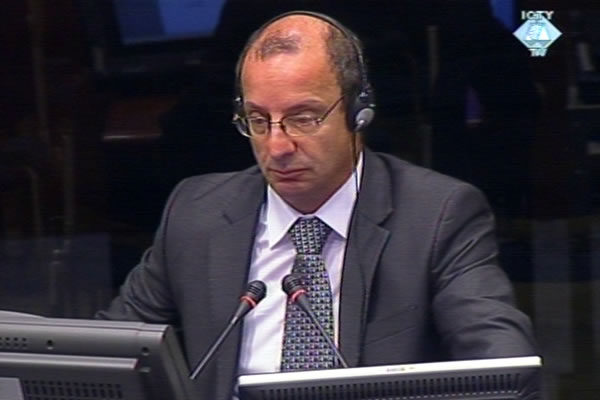Home
THOUSAND DAYS OF UNCERTAINTY
The witness, who was a victim in two incidents that were part of the sniper and artillery terror campaign in Sarajevo, talked at the trial of Radovan Karadzic about the consequences of ‘a thousand days spent in serious uncertainty’. He was followed by a ballistic expert of the Security Services Center in Sarajevo. This witness took part in the investigation of the Markale incident of 5 February 1994 and a number of other incidents
 Alen Gicevic, witness at the Radovan Karadzic trial
Alen Gicevic, witness at the Radovan Karadzic trial At the trial of Radovan Karadzic, the prosecution called to the witness stand Alen Gicevic. During the siege of Sarajevo Gicevic was injured twice: the first time, he was hit by a shell fragment in the leg and stomach and the second time he was shot by a sniper while he was in a tram. The witness’s written statement based on his previous evidence at the trials of Dragomir Milosevic and Momcilo Perisic was admitted into evidence.
The sniper incident in which Gicevic was shot in the leg on 3 March 1995 is listed in the annex to the indictment against Radovan Karadzic. That day, the witness and another man in the tram were hit as they travelled from Novo Sarajevo to the city center. The witness estimated that the shots were fired when the tram passed by the Holiday Inn Hotel from the direction of Grbavica, which was controlled by the VRS.
The prosecutor asked the witness about the consequences still felt by the survivors of the siege of Sarajevo. ‘A thousand days spent in serious uncertainty had to have an impact on normal persons. We try to find a way to forget it somehow. But, as a doctor in Sarajevo said – the brain can forget, but the body can’t’, the witness said.
After Gicevic, the prosecution called Mirza Sabljica, ballistic expert who worked for the Security Services Center in Sarajevo. In 1994 and 1995, Sabljica was involved in the investigation of several sniper and artillery incidents listed in the indictment against Karadzic, including about a dozen investigations of the attacks on trams in Sarajevo. According to Sabljica, the investigations showed that the shots were fired from skyscrapers in Grbavica. Sabljica is giving evidence under his name, but with image distortion as a protective measure.
According to the witness, after the VRS withdrew from Grbavica in early 1996 fortified sniper nests were found in four skyscrapers in the Lenjinova Street and in the Metalka building. From there the VRS snipers had a clear line of sight to the Zmaja od Bosne Street and the tram tracks running along it. The street was known as the ‘sniper alley’ because it was exposed to sniper fire during the war.
The witness took part in the investigation of the Markale incident of 5 February 1994. A 30-minute video recording taken by the Security Services Center personnel that day at the Markale town market was admitted into evidence. In his cross-examination of British general Michael Rose last week, Karadzic argued that the Bosnian side ‘drilled a hole’ in the asphalt where the shell hit. The prosecutor today showed a segment where a French Battalion soldier is prizing out a shell stabilizer fin out of the asphalt with his knife. Prosecutor wanted to show that the BH Army did not drill a hole at the point of impact, hence disproving Karadzic’s claims that that site had been ‘doctored’ to blame the Serb side for the incident.
Karadzic initially asked for 20 hours to cross-examine Mirza Sabljica, but has in the meantime changed his mind: he now claims even 20 hours is not enough, asking for a total of 30 hours. The Trial Chamber will decide on Karadzic’s request tomorrow, as the trial continues.
Linked Reports
- Case : Karadzic
- 2010-10-08 KARADZIC HAD ABSOLUTE CONTROL
- 2010-10-07 KARADZIC – NATO WAS “TRIGGER HAPPY”
- 2010-10-06 KARADZIC: NO RECONCILIATION IF WE SHELLED THE MARKALE TOWN MARKET
- 2010-10-12 KARADZIC REJECTS SARAJEVO INVESTIGATIONS
- 2010-10-13 ‘RAISING DOUBTS’ ABOUT SARAJEVO INVESTIGATIONS FINDINGS
- 2010-10-14 KARADZIC: WE NEED RECONCILIATION THIS YEAR, NOT NEXT
